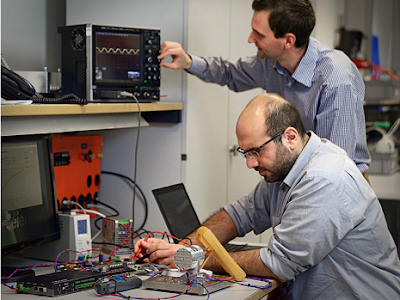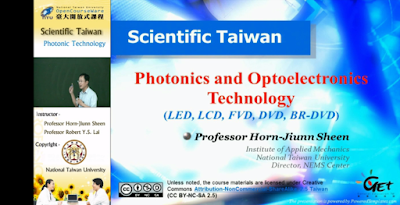Electronic Circuits Daegu University Jeong yu jeong
domingo, 24 de julho de 2016
A high-speed motor for satellites -ETH Zurich (Department of Information Technology and Electrical Engineering)
22.07.2016 | News By: Peter Rüegg
A dizzying 150,000 revolutions per minute: researchers from ETH Zurich (Department of Information Technology and Electrical Engineering) and the ETH spin-off Celeroton have developed an ultra-fast magnetically levitated electric motor for reaction wheels. The high speed of rotation allows intensive miniaturisation of the drive system, making it attractive for use in small satellites. “Actually, there is nothing particularly new about it,” is the modest line taken by Arda Tüysüz, a postdoc at ETH Zurich’s Power Electronic Systems Laboratory (PES). “The electronics, the magnetic bearings, understanding of the basic physical principle – it was all there already.” However, the engineering skill of the PES researchers is evident in their ability to combine these fundamentals into high-speed motor, which can run 20 times faster than the state of the art, and which is vastly smaller and more energy-efficient. In collaboration with the ETH spin-off Celeroton, Tüysüz and colleagues have developed a new kind of magnetically levitated reaction wheel motor that reaches speeds of more than 150,000 revolutions per minute.
Electrically driven reaction wheels of this kind are used within satellites to change the satellite’s attitude. Here, the reaction wheel is connected to an electric motor via a shaft (rotor). As soon as the flywheel driven by this motor rotates in one direction about its own axis, a torque is transmitted to the satellite, which then rotates in the opposite direction and thus a new orientation.
Existing systems have numerous disadvantages In existing systems, the rotors and reaction wheels are typically mounted on ball bearings that wear down relatively quickly. In order to minimise mechanical wear, motors of this kind are usually operated slower than 6,000 revolutions per minute. They also have to be stored in a hermetically sealed housing in a low-pressure nitrogen atmosphere, in order to avoid oxidisation of the materials and evaporation of the lubricant.
Furthermore, the balls in a ball bearing are not exactly identical, giving rise to forces that together with the imbalance of the rotor transfer microvibrations to the satellite’s housing. This reduces the positioning accuracy, which satellites must exhibit in order to allow, for example, laser measurement or inter-satellite communication. In other words, enough reasons for ETH Zurich and Celeroton to design a new, magnetically levitated electric drive system.
LINK FULL PAPER
https://www.ethz.ch/en/news-and-events/eth-news/news/2016/07/high-speed-motor-for-satellites.html
terça-feira, 19 de julho de 2016
domingo, 17 de julho de 2016
SCIENTIFIC TAIWAN PHOTONIC TECHNOLOGY LIGHT AND ELECTRICITY PROF. HORN JIUNN ,PROF. ROBERT Y.S LAI NATIONAL TAIWAN UNIVERSITY OPENCOURSEWARE
sábado, 16 de julho de 2016
The Arduino microcontroller-Arduino MEGA 2560 -Arduino programming with MATLAB- SEJONG UNIVERSITY-SEOUL SOUTH KOREA
The Arduino microcontroller / Arduino MEGA 2560 / Arduino IDE/ Arduino programming with MATLAB / Simulink, DI, DO, AI, AO, PWM
“LAS CENTRALES HIDROELÉCTRICAS ME MOTIVARON A DESCUBRIR CÓMO LLEGA LA ENERGÍA A LAS CASAS” DR. JOEL DAVID MELO TRUJILLO ( UNESP-UNMSM)
Se suele decir que la inspiración llega en el momento o lugar menos esperado. Una central hidroeléctrica probablemente sería el último lugar imaginado por muchos, pero Joel, un niño muy curioso se sentía muy atraído por esta maravilla de la ingeniería. Cada vez que pasaba frentre a ella se preguntaba cómo era posible que allí se generara energía eléctrica y cómo ésta llegaba hasta las bombillas para iluminar su hogar. Esta inquietud lo llevó a desarrollar el proyecto titulado “La Casa del Futuro” en sus años escolares para competir en la Feria Escolar de Ciencia y Tecnología organizada por el CONCYTEC. Este proyecto terminó por reafirmar su pasión por la ingeniería a tal punto que a día de hoy es investigador del Departamento de Ingeniería Eléctrica de una reconocida universidad brasileña.
Conozcamos la historia del Dr. Joel David Melo Trujillo.
¿En qué colegio realizaste los estudios de primaria y secundaria? ¿Cómo fue la formación en ciencias que recibiste en tu colegio?
Los estudios de primaria y secundaria los realicé en los colegios particulares Lourdes y Santa Rita, respectivamente. Esos colegios se encuentra en el distrito de Lurigancho – Chosica, en la provincia de Lima, departamento de Lima. En la primaria, los profesores fomentaban los concursos en literatura y matemáticas, en el quinto grado de primaria llegué a ocupar el segundo puesto en el concurso de matemáticas. En el último año de la secundaria, dentro del programa curricular se preparó a los alumnos para el concurso de ciencia y tecnología organizado por CONCYTEC. Llegué hasta la etapa departamental con el proyecto titulado “La Casa del Futuro”. Tengo que reconocer que los profesores del área de ciencias exactas siempre motivaban a los alumnos a estudiar las materias, mas los recursos como laboratorios adecuados eran escasos, por ejemplo, no se tenía un adecuado laboratorio de química, teníamos que donar tubos de ensayo y traer algunos materiales de casa. También, no existía biblioteca, cuando estudié no todos tenían computadores en la casa y menos internet, así las informaciones para poder complementar lo aprendido en las aulas era poco.
¿Qué carrera estudiaste en pre-grado y en qué universidad? ¿por qué la elegiste o quién te motivó a elegirla?¿Cómo crees que nació tu vocación científica?
En el año 2002 entré a la Universidad Nacional Mayor de San Marcos (UNMSM) a la Escuela Profesional de Ingeniería Eléctrica. Mi vocación por la ingeniería eléctrica nació por causa del proyecto que mencioné en la respuesta anterior. Además, en Chosica están localizadas varias centrales hidroeléctricas, el pasar siempre por las centrales y ver las líneas de transmisión, éstas me llamaban la atención y me incentivaron a descubrir cómo es que llegaba la energía a las casas.
¿Qué estudios de post-grado haz realizado?
En el año 2009 llegué a Brasil para realizar estudios de post-grado en la UNESP campus de Ilha Solteira, donde obtuve los grados de magíster y doctor en los años 2010 y 2014, respectivamente. La investigación de post-grado fue realizada en el LaPSEE. Además colaboré con las investigaciones de otros alumnos y miembros de ese laboratorio.
Para realizar los estudios de postgrado ¿conseguiste alguna beca? ¿cómo la conseguiste?
En el año 2008, conocí al profesor peruano Ruben Romero de la UNESP, campus de Ilha Solteira, en una conferencia que se realizó en la Universidad Nacional de Ingeniería (UNI). El profesor mencionó que el sistema de post-grado es gratuito, además explicó los detalles del sistema de becas en Brasil. Existen varios tipos de becas, las cuales pueden ser agrupadas en institucionales y no institucionales. Las becas institucionales son auxilios económicos para que los alumnos se dediquen a tiempo integral a la investigación, imposibilitándolos, en la mayoría de las veces, a trabajar o recibir otro tipo de apoyo durante los estudios de post-grado. La atribución de esa beca depende de las programas de post-grado de cada universidad, en general, existe un sistema de selección. Las becas institucionales son ofrecidas en mayor número que las otras y fue la que obtuve. El sistema de selección que participé consistió en presentar mi hoja de vida y un proyecto de investigación.
PUEDES LEER EL ARTICULO COMPLETO EN LA PAGINA WEB ORIGINAL
http://www.cientificos.pe/entrevista/las-centrales-hidroelectricas-me-motivaron-a-descubrir-como-llega-la-energia-a-las-casas/
sexta-feira, 15 de julho de 2016
Lec06 電子學(一) 第二章 Operational Amplifiers
第二章 Operational Amplifiers (1/6) 授課教師:電子物理系 陳振芳教授 課程資訊:http://ocw.nctu.edu.tw/course_detail.... 授權條款:Creative Commons BY-NC-SA 更多課程歡迎瀏覽交大開放式課程網站:http://ocw.nctu.edu.tw/ 本課程同時收錄至國立交通大學機構典藏,詳情請見: http://ir.nctu.edu.tw/handle/11536/10...
The World Economy and the Traditional Confucianism (《新百家學堂》全球經濟與傳統儒學) ( Sun Chen) The impact of globalization on the world economy
NTU Open Forum for New Intellectuals: The World Economy and the Traditional Confucianism (《新百家學堂》全球經濟與傳統儒學) ( Sun Chen) The impact of globalization on the world economy
Assinar:
Postagens (Atom)










































 JOSIL ARTISTA PLASTICO FORTALEZA CEARA BRASIL AV.HERACLITO GRAÇA 41 TEL(85)32542378
JOSIL ARTISTA PLASTICO FORTALEZA CEARA BRASIL AV.HERACLITO GRAÇA 41 TEL(85)32542378
















